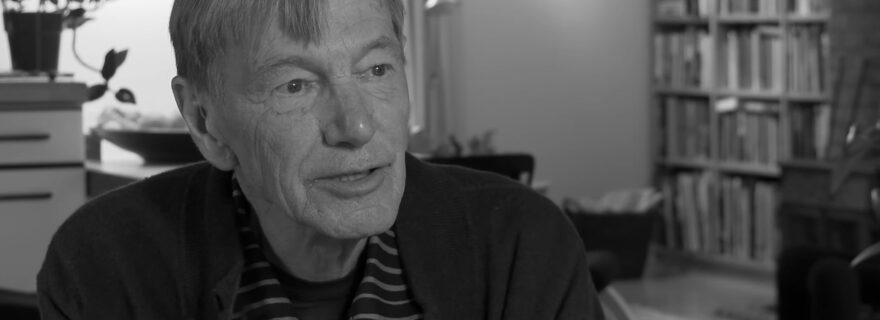Wim Hofstee (1936-2021) and the Theory of Psychological Relativity
Wim Hofstee was one of the designers of post WWII psychological science in the Netherlands. His contribution can roughly be summarized in two concepts: Prediction and Relativity. And decades of assiduous work, using the method of Thinking.
“All those who feel you have learned from me, I learned from you.” These were the closing words of Wim Hofstee’s farewell lecture as a professor at the University of Groningen. He died last month. Together with scholars like Willem Albert Wagenaar (in Leiden) , and Nico Frijda (in Amsterdam), he built the foundations of psychological science in the Netherlands, after WWII. To that end, Professor Wim Karel Bernhard Hofstee “WKB” to his friends, used the method of Thinking. He thought about ‘big questions’, or at least difficult ones, and proposed sharp, original and effective, answers always solidly rooted in math and philosophy. He was the kind of teacher you dream of when, in high school, you fantasize about studying psychology. Wim Hofstee was a shy, intense man of integrity, and a most charming conversation partner. He lacked any talent for feeling superior to his students and employees, nor could he feel inferior towards any authority or manager. He was the type of intellectual with whom you would hope to be accorded a private conversation, where you would want to keep up with his eloquence, hoping to be noticed. The conversation would require, however, that you could stand the smoke from an uninterrupted chain of cigarettes for the duration.
Psychology of Personality
Hofstee’s earliest work was on personality psychology. In the footsteps of his own role model, Ben Kouwer, he developed a theory that conceptualized personality as a social and a ‘recursive’ thing. Personality is the average of all judgments and item scales applying to that person in a configuration of situations. This view on personality, completely new at that time, denied that it was a constant characteristic of an individual; rather it was the sum of external judgments attributed to the person, like an onion that could be peeled layer by layer, with nothing but emptiness at its core. The implications were precise and practical: personality assessments and clinical diagnoses benefit from averaging across multiple judges, judgments, and contexts.
Difficult questions
Hofstee was fond of difficult qualitative judgment problems. For example, how can one assess what is good art? And who is a good artist? He dissected these problems from the point of view of practice: who deserves the grants? How do you select the best art for an exhibition? My own master’s thesis with Hofstee held another striking example: how to assess the legal liability of an offender in psychological terms. This question held the typical Hofsteean mix of pure philosophical reflection and hard practical consequences. The result of elaborate thinking under his guidance was that any assessment hinged on the unique causal force of any possible psychopathological state on the specific crime committed. Or, put more formally: the likely ratio of the probability of a crime committed in an established specific pathological state, divided by the probability of that crime being committed without that state. The study resulted in my first scientific publication in a Dutch journal, for which I won my first ever prize.
Prediction
Long before the current prediction framework arose in psychological theorizing (the brain is a prediction machine, language processing is prediction based, decision-making is avoiding prediction errors, etc.), Hofstee realized the essential concept of prediction in psychology. He posited that prediction is important in human cognition, and also in communicating scientific results. Hofstee fleshed out a completely novel model of scientific advancement in psychology: the betting model of psychological science. I believe it is his masterpiece.
‘Good’ psychological science
Well before scientific practices like pre-registration emerged, Hofstee developed his ‘betting model’ of science (1984). It is a rigorous answer for psychologists’ struggle with the question: what is good psychological science? And who is a good scientist? There were and still are many views on this. For example: the best scientist is the most productive author, the most inspiring teacher, the most creative thinker, the best team leader, the best media communicator. They have the most rejected null-hypotheses, most citations, highest H-index, strongest earning power, or the densest network. Finally, the best scientist might be the one to whom an academic authority awards that title.
All these criteria have drawbacks, however, mainly resulting from strategic behavior that adapts to the criterion used. For example, maximizing publication output can be achieved by minimizing its relevance, spreading results out in scattered hypotheses, each reported in a separate paper. The availability of money and personnel (PhDs, postdocs) obviously increases output. H-indices increase with age, but are also (ironically) enhanced by making controversial claims or very novel ones... or untrue claims that will be cited as such. Earning power can nowadays be boosted by hiring grant writing support. Null hypotheses can be rejected by eliminating outliers and adding more observations. And academic authorities might prioritize their dedicated popular mate rather than that brilliant but introvert and shy young woman. Strategic behavior tailored to these criterions might obstruct rather than advance science.
Research originates in a bet
Hofstee’s radical proposal is that scientific knowledge and competence arises if – and only if – there is a bet. The bet is between two or more flesh and blood scientists who make different predictions about the outcome of a study, designed in dialog, that results in a final version approved by both. ‘Good science’ discussions collapse into one sharp concrete criterion: How good is a theory or a researcher at predicting outcomes about a disputed subject in their field of expertise.
Hofstee’s proposal elegantly annihilates many undesirable influences on scientific practice in one blow. It does not deny that productivity, money, creativity, or even having friends in the right places do play a role in scientific competence – but only insofar as these factors demonstrably result in the scientist making better predictions about relevant scientific issues. Note that the betting model solves not only the question of how to obtain the best scientific output, but also the question of relevance: in the absence of disagreement about a hypothesis, no research takes place. Hence, topics nobody cares about, or obvious topics, are filtered out automatically. After the data of an experiment are gathered, the payoffs are distributed. And any new disagreement about that result generates new research. Hofstee would call these payoffs ‘units of reputation’ leaving to the scientific community any further operationalization, if desired.
The principle of psychological relativity
A final remarkable Hofsteean proposal is that any psychological proposition, be it a diagnosis or a scientific result, is subject to a human response that may immediately falsify it. In other words, in psychology, the very fact of measuring something potentially changes what is measured. This relativity is an impactful particularity for psychology. One example is the response shift: people changing their standards for self-evaluations after a psychological intervention. A person who hears themselves being diagnosed as ‘neurotic’ may decide to behave less neurotically in the future, thus cancelling the diagnosis. Hofstee pointed to the issue for the neurosciences: what would happen in the brain if we measured brain activity during an emotional task, reported that observed brain activity to the participant, and remeasured the same person?
Local not global
Unfortunately for science, Hofstee was local-minded. He had no ambition to become famous, followed, liked, or globally renowned. He became a full professor in his thirties at the same university where he had been a student, in the region where he grew up, and stayed there until he became emeritus. He was a brilliant and passionate writer in his native language and would grumpily shrug his shoulders when encouraged to disseminate his contributions more widely, let alone use modern media to do so. His international paper on the betting model has remained virtually unnoticed, with a mere 25 citations noted to date. “I just write it up”, he would say, “and then it’s up to them to read it – or not”. Now that he can object no longer, let’s get retweeting!
Blog written by Fenna Poletiek:
Assistant Professor, Leiden University, Netherlands.
Senior Investigator, Max Planck institute of Psycholinguistics, Nijmegen, Netherlands.
Visiting professor Institute of Bioscience, Newcastle University.



